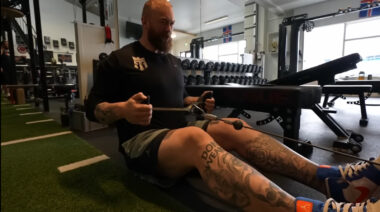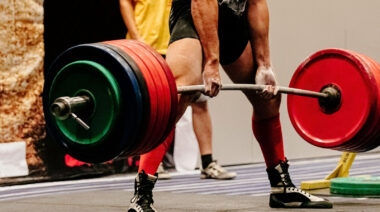The deadlift is a lift that divides a lot of opinions and makes a lot of people nervous. In my article on which deadlift is right for you, I talked about how to pick a deadlift variation that would be best suited to your body type and allowing your anatomy to dictate your style. And now here are five simple rules to ensure you’re deadlifting safely every workout so you can deadlift with confidence!
The deadlift is a lift that divides a lot of opinions and makes a lot of people nervous. In my article on which deadlift is right for you, I talked about how to pick a deadlift variation that would be best suited to your body type and allowing your anatomy to dictate your style. And now here are five simple rules to ensure you’re deadlifting safely every workout so you can deadlift with confidence!
1. Pick the Correct Weight
Lifting with your ego is a fantastic way to hurt yourself. You see those super strong men and women lifting big weights? They earned that level of strength through consistent training, and you should too. Make small, consistent increases in weight to get stronger. Adding an extra plate to the bar too soon isn’t impressing anyone.
2. Don’t Let the Bar Move Forward
This is one of the most common errors in the deadlift. It typically happens when you squat to assume the starting position rather than hinge.3 When you are in a squat position, your shins will move forward as you lift the bar, causing it to swing forward of the body.
We want the bar to move directly over the midfoot in a vertical line. If the bar moves forward even by a few inches, it’s dangerous. Lifting a load that isn’t balanced over the midfoot leads to lumbar flexion and causes an increased risk of disc injury.1
3. Don’t Lift Your Hips Too Early
This usually happens on a heavy weight when you try to lift the weight quickly. When the hips lift early, it effectively turns the deadlift into a stiff-legged deadlift. This reduces the contribution from the quadriceps and places more stress onto the hamstrings and low back.2 Trying to lift a heavy weight with less muscle mass involved is a potential injury risk. It also leads to missed reps and a bruised ego.
4. Keep Your Back in Extension
I know that you know, but it needs to be said. Many gym goers fail to do this, or they do it for the first reps of a set but relax towards the end. Some people also find this step difficult, especially older persons.3
Some small degree of rounding is acceptable under the right circumstances. However, if you are unable to achieve extension in your deadlifts, consider raising the bar off the ground on some weight plates or even performing rack pulls instead.4
5. Lower the Bar Properly
This is something far too many of us get wrong. Don’t bend your knees and try to squat the weight down. If you do this your back will round as the bar passes your knees, exposing you to an injury risk in the same way as the bar swinging forward does.1
To lower the barbell, push your hips back until the bar passes your knees, then lower in a vertical line in front of your shins. Don’t let go of the bar, but this should be a controlled drop rather than a slow lower. You want to conserve for energy for the actual lifting. Don’t drop the bar from the top, just don’t. Ever.
References:
1. Magerl, F., and M. Aebi. “A Comprehensive Classification of Thoracic and Lumbar Injuries“, AO ASIF Principles in Spine Surgery, 1998, 20-41. doi:10.1007/978-3-642-58824-2_4.
2. Swinton, Paul A., Arthur Stewart, Ioannis Agouris, Justin Wl Keogh, and Ray Lloyd. “A Biomechanical Analysis of Straight and Hexagonal Barbell Deadlifts Using Submaximal Loads“, Journal of Strength and Conditioning Research 25, no. 7 (2011): 2000-009. doi:10.1519/jsc.0b013e3181e73f87.
3. Rippetoe, Mark, and Stephani Elizabeth Bradford. Starting Strength: Basic Barbell Training. Wichita Falls, TX: Aasgaard Company, 2017.
4. Malyszek, Kylie K., Roque A. Harmon, Dustin D. Dunnick, Pablo B. Costa, Jared W. Coburn, and Lee E. Brown. “Relationship Between Dynamic and Isometric Force Measured at the Mid-Thigh and Deadlift Positions“, Medicine & Science in Sports & Exercise 48 (2016): 433. doi:10.1249/01.mss.0000486304.19496.b0.






